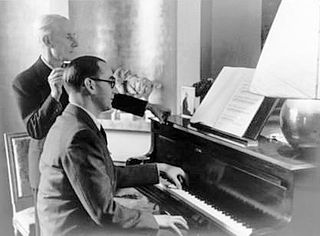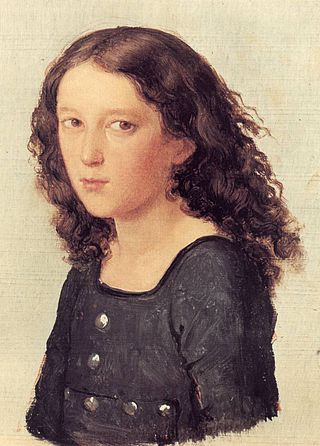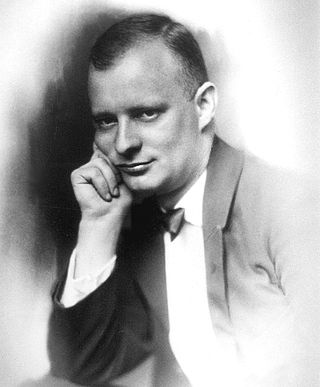
Mendelssohn's Piano Concerto No. 1 in G minor, Op. 25, was written in 1830–31, around the same time as his fourth symphony ("Italian"), and premiered in Munich on 17 October 1831. This concerto was composed in Rome during a travel in Italy after the composer met the pianist Delphine von Schauroth in Munich. The concerto was dedicated to her. Mendelssohn attended one party after another in Munich in October 1831, the month of the premiere, but he also played chamber music and taught double counterpoint. He performed the piece himself at the premiere, which also included performances of his Symphony No. 1 and the Overture from Midsummer Night's Dream. He had already written a piano concerto in A minor with string accompaniment (1822) and two concertos with two pianos (1823–24).
Sergei Prokofiev began his Violin Concerto No. 1 in D major, Op. 19, as a concertino in 1915 but soon abandoned it to work on his opera The Gambler. He returned to the concerto in the summer of 1917. It premiered on October 18, 1923 at the Paris Opera with Marcel Darrieux playing the violin part and the Paris Opera Orchestra conducted by Serge Koussevitzky. Igor Stravinsky made his debut as conductor at the same concert, conducting the first performance of his own Octet for Wind Instruments.

The Piano Concerto for the Left Hand in D major was composed by Maurice Ravel between 1929 and 1930, concurrently with his Piano Concerto in G major. It was commissioned by the Austrian pianist Paul Wittgenstein, who lost his right arm during World War I. The Concerto had its premiere on 5 January 1932, with Wittgenstein as soloist performing with the Vienna Symphony Orchestra.
Piano Concerto No. 3 in C major, Op. 26, is a piano concerto by Sergei Prokofiev. It was completed in 1921 using sketches first started in 1913.
Sergei Prokofiev set to work on his Piano Concerto No. 2 in G minor, Op. 16, in 1912 and completed it the next year. But that version of the concerto is lost; the score was destroyed in a fire following the Russian Revolution. Prokofiev reconstructed the work in 1923, two years after finishing his Piano Concerto No. 3, and declared it to be "so completely rewritten that it might almost be considered [Piano Concerto] No. 4." Indeed its orchestration has features that clearly postdate the 1921 concerto. Performing as soloist, Prokofiev premiered this "No. 2" in Paris on 8 May 1924 with Serge Koussevitzky conducting. It is dedicated to the memory of Maximilian Schmidthof, a friend of Prokofiev's at the Saint Petersburg Conservatory who had killed himself in 1913.

The Symphony No. 4 in A major, Op. 90, commonly known as the Italian, is an orchestral symphony written by German composer Felix Mendelssohn.

The Violin Concerto No. 2 in G minor, Op. 63, written in 1935 by Sergei Prokofiev, is a work in three movements:
- Allegro moderato
- Andante assai
- Allegro, ben marcato

Sergei Prokofiev's Symphony No. 7 in C-sharp minor, Op. 131, was completed in 1952, the year before his death. It is his last symphony.

The Concerto in D major for Oboe and Small Orchestra, AV 144, TrV 292, was written by Richard Strauss in 1945. It was one of the last works he composed near the end of his life, during what is often described by biographers, journalists and music critics as his "Indian summer."
The last complete piano concerto by Sergei Prokofiev, Piano Concerto No. 5 in G major, Op. 55, dates from 1932.

The Piano Concerto No. 18 in B♭ major, KV. 456 is a piano concerto by Wolfgang Amadeus Mozart. In Mozart's own catalogue of his works, this concerto is dated 30 September 1784.
Aram Khachaturian's Piano Concerto in D-flat major, Op. 38, was composed in 1936. It was his first work to bring him recognition in the West, and it immediately entered the repertoire of many notable pianists.

Sergei Prokofiev's Piano Sonata No. 8 in B♭ major, Op. 84 is a sonata for solo piano, the third and longest of the three "war sonatas", with performances typically lasting around 30 minutes. He completed it in 1944 and dedicated it to his partner Mira Mendelson, who later became his second wife. The sonata was first performed on 30 December 1944, in Moscow, by Emil Gilels.
An organ concerto is a piece of music, an instrumental concerto for a pipe organ soloist with an orchestra. The form first evolved in the 18th century, when composers including Antonio Vivaldi, George Frideric Handel and Johann Sebastian Bach wrote organ concertos with small orchestras, and with solo parts which rarely call for the organ pedal board. During the Classical period the organ concerto became popular in many places, especially in Bavaria, Austria and Bohemia, reaching a position of being almost an integral part of the church music tradition of jubilus character. From the Romantic era fewer works are known. Finally, there are some 20th- and 21st-century examples, of which the concerto by Francis Poulenc has entered the basic repertoire, and is quite frequently played.
The Concerto for Two Pianos and Orchestra, Op. 88a, was written by Max Bruch in 1912. It is in 4 movements, written in the rarely seen key of A-flat minor, and takes about 25 minutes to perform.
Benjamin Britten's Violin Concerto, Op. 15, was written from 1938 to 1939 and dedicated to Henry Boys, his former teacher at the Royal College of Music. It was premiered in New York on 29 March 1940 by the Spanish violinist Antonio Brosa with the New York Philharmonic conducted by John Barbirolli. A revised version of the concerto appeared in 1951, including alterations of the solo violin part prepared with the assistance of Manoug Parikian. It was performed by Bronislav Gimpel and the Royal Philharmonic Orchestra under Thomas Beecham.

The Concerto for Two Pianos and Orchestra in A♭ major was written by Felix Mendelssohn when he was 15 years old. and is dated 12 November 1824. Written for two pianos and a full orchestra, the work received its first public performance in Berlin, in 1825. The composer and his mentor Ignaz Moscheles, who inspired its composition, were the soloists. He performed it again on 20 February 1827 at Stettin, where the cathedral organist, composer, baritone singer and conductor Carl Loewe organised concerts. Loewe and Mendelssohn were the two piano soloists on that occasion.
Siegfried Rapp was a German pianist who lost his right arm during World War II and then focused on the left-hand repertoire. He is now mainly remembered for being the first to perform Prokofiev's Piano Concerto No. 4 for the Left Hand, Op.53.

Klaviermusik mit Orchester, Op. 29, is a 1923 piano concerto by Paul Hindemith. Subtitled Klavier nur linke Hand, it is a piano concerto for the left hand alone. It was commissioned by the pianist Paul Wittgenstein, who lost his right arm in the World War. He never played the piece, and when he died, his widow refused access to the score. The premiere, after her death, was played in Berlin in 2004, with Leon Fleisher as the soloist and the Berlin Philharmonic conducted by Simon Rattle. It was published by Schott.








